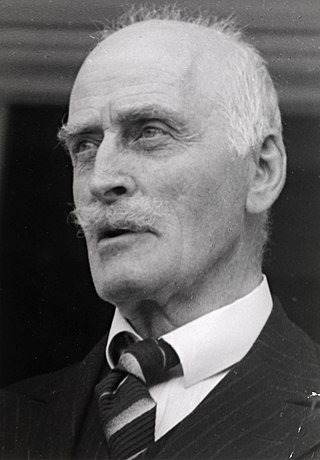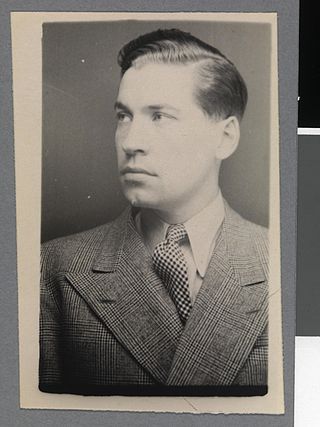Related Research Articles

Knut Hamsun was a Norwegian writer who was awarded the Nobel Prize in Literature in 1920. Hamsun's work spans more than 70 years and shows variation with regard to consciousness, subject, perspective and environment. He published more than 23 novels, a collection of poetry, some short stories and plays, a travelogue, works of non-fiction and some essays.

The Nasjonal Samling was a Norwegian far-right political party active from 1933 to 1945. It was the only legal party of Norway from 1942 to 1945. It was founded by former minister of defence Vidkun Quisling and a group of supporters such as Johan Bernhard Hjort – who led the party's paramilitary wing (Hirden) for a short time before leaving the party in 1937 after various internal conflicts. The party celebrated its founding on 17 May, Norway's national holiday, but was founded on 13 May 1933. Nasjonal Samling was made illegal and disbanded at the End of World War II in Europe, on 8 May 1945.

Aftenposten is Norway's largest printed newspaper by circulation. It is based in Oslo. It sold 211,769 daily copies in 2015 and estimated 1.2 million readers. It converted from broadsheet to compact format in March 2005. Aftenposten's online edition is at Aftenposten.no. It is considered a newspaper of record for Norway.

Hunger is a novel by the Norwegian author Knut Hamsun published in 1890 by P.G. Philipsens Forlag. The novel has been hailed as the literary opening of the 20th century and an outstanding example of modern, psychology-driven literature. Hunger portrays the irrationality of the human mind in an intriguing and sometimes humorous manner.

Rolf Jørgen Fuglesang was a Norwegian secretary to the Nasjonal Samling government of Vidkun Quisling 1940–1941 and minister 1941–1942 and 1942–1945. He was also President of the Kulturting 1943–1945.
Events in the year 1940 in Norway.
Events in the year 1941 in Norway.
Gustav Smedal was a Norwegian jurist and irredentist activist.
Jørgen Haugan in Trondheim is a Norwegian author and lecturer. He was written a number of books, principally biographies of noted Scandinavian writers.
Events in the year 2009 in Norway.
Conrad Wilhelm Eger, often referred to as C. W. Eger was a Norwegian businessperson. An associate of Sam Eyde, Eger was the chief executive officer of Elkem from 1912 to 1950, and later played a role in building the Norwegian iron industry.

Edvard Freydar Beyer was a Norwegian literary historian, literary critic, and professor at the University of Oslo from 1958 to 1990.
Edda. Scandinavian Journal of Literary Research is a magazine for research on Scandinavian literature, and for literary researchers in the Scandinavian countries. The magazine is based in Oslo.
Atle Kittang was a Norwegian literary researcher and literary critic.

Carl Nicolai Stoud Platou was a Norwegian civil servant and politician. A jurist by education, he is best known for his civil servant career in the Norwegian Ministry of Justice and the Police, which spanned from 1911 to 1941. He was promoted to deputy under-secretary of state in 1926, but was dismissed and later incarcerated for listening to hostile radio in 1941, during the occupation of Norway by Nazi Germany. He returned after the war as Chief Minister of the Ministry of Justice and the Police in May 1945 and County Governor of Akershus and Oslo from 1945 to 1955. He had been involved in politics before the war as well, as deputy mayor of Aker.

The Quisling regime, or Quisling government are common names used to refer to the fascist collaboration government led by Vidkun Quisling in German-occupied Norway during the Second World War. The official name of the regime from 1 February 1942 until its dissolution in May 1945 was Den nasjonale regjering. Actual executive power was retained by the Reichskommissariat Norwegen, headed by Josef Terboven.
Haaken Severin Mathiesen was a Norwegian landowner and businessperson in the forestry sector.
Jørgen Magnus Finne-Grønn was a Norwegian diplomat.

Tore Hamsun was a Norwegian painter, writer, and publisher born in Hamarøy Municipality. He was the son of the Nobel Prize winning novelist Knut Hamsun and actress Marie Hamsun.
References
- 1 2 Gibbs, Walter (27 February 2009). "Norwegian Nobel Laureate, Once Shunned, Is Now Celebrated". The New York Times. Retrieved 16 May 2011.
- 1 2 Ringdal, Nils Johan (1995). "Hamsun, Knut". In Dahl, Hans Fredrik (ed.). Norsk krigsleksikon 1940-45 (in Norwegian). Oslo: Cappelen. Archived from the original on 25 May 2011. Retrieved 28 July 2009.
- ↑ Løiten, Tore Marius; Gran, Marianne, eds. (2009). Førstesiden. Aftenpostens førstesider gjennom 150 år (in Norwegian). Oslo: Schibsted. p. 73.
- 1 2 3 Rottem, Øystein. "Knut Hamsun". In Helle, Knut (ed.). Norsk biografisk leksikon (in Norwegian). Oslo: Kunnskapsforlaget. Retrieved 28 July 2009.
- 1 2 Kittang, Atle. "Atle Kittang: Knut Hamsun's posthumous reputation". Hamsun Centre . Retrieved 10 April 2011.
warrior for humankind and a preacher of the gospel of justice for all nations
- ↑ Rivedal, Marianne (7 June 2005). "– Nazist – men ingen ond person". Tvedestrandsposten (in Norwegian). Retrieved 28 July 2009.
- ↑ Steinkjer, Mode (8 January 2009). "Ingen ende på Hamsun". Dagsavisen (in Norwegian). Archived from the original on 9 August 2009. Retrieved 28 July 2009.
- ↑ Plassen, Pål Hovengen (20 February 2009). "Hamsuns fire dødssynder" (in Norwegian). Norwegian Broadcasting Corporation. Retrieved 28 July 2009.
- ↑ Haugan, Jørgen (23 October 2004). "Det norske Hamsun-traume". Aftenposten (in Norwegian). Archived from the original on 9 August 2009. Retrieved 28 July 2009.